This was published 5 years ago
Cycling in southern France: Along one of Europe's oldest canals, the Canal du Midi
By Elspeth Callender
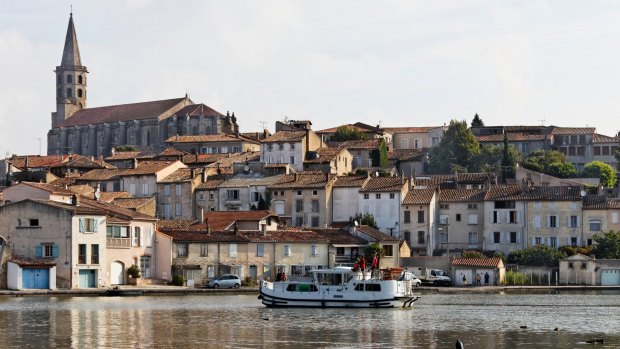
Houseboat on the Canal du Midi.Credit: Alamy
It's summertime in southern France and we're cycling the towpath of a canal built more than a century before the bicycle was even invented.
One of Europe's oldest canals still in operation, and arguably its most beautiful, connects Toulouse to the Mediterranean port of Sete. While peddling its 240-kilometre length and back again, stopping often to let locals stuff us with food and wine, I do wonder how the guy who poured his fortune and energy into the Canal du Midi might feel to know his creation is now used purely for fun.
Before we set off many Toulousains told us we were embarking on a trip they'd long intended to do themselves. The canal winds through La France Profonde – anywhere in the country authentic rural life still exists – passing settlements predating its construction such as medieval Castelnaudary and Carcassonne and the former Phoenician cities of Agde and Béziers.
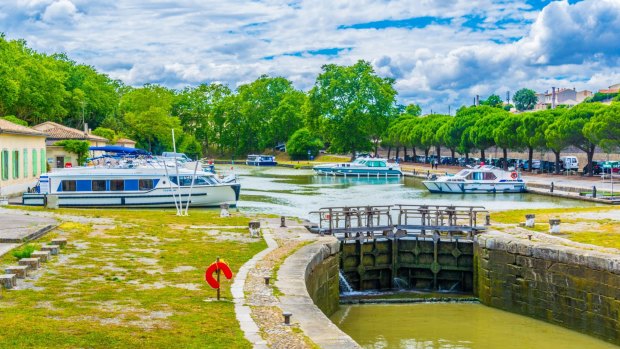
Tourist boats moored on Canal du Midi in the centre of Carcassonne, France.Credit: Shutterstock
Over the centuries people from these places dreamt of a watery shortcut between the Atlantic and the Mediterranean, an alternative passage to the 3000-kilometre storm-prone pirated sea route through the Strait of Gibraltar.
The river Garonne already linked Toulouse to the Atlantic while Toulouse to the Mediterranean required an artificial waterway. The lack of a water source to fill a canal that needed to flow at 583 pied du roi (the king's foot) above sea level at its highest point was the consistent conundrum. Until one day, in 1654, salt tax collector Pierre Paul Riquet hit on the idea of channelling mountain streams into a reservoir.
In his late-50s by then, Riquet had power, vision, ingenuity, wealth and contacts. I'm guessing he was also the obsessive type. The working hydrotechnical model he constructed in the grounds of his private castle got the attention of the Archbishop of Toulouse, who introduced him to the minister of finance who was sure King Louis XIV would be keen.
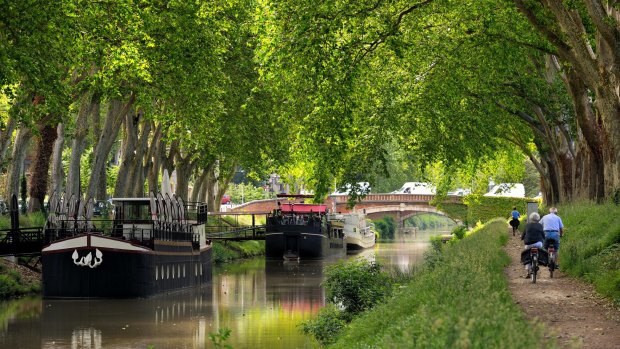
Along the Canal du Midi in Toulouse, France.Credit: Shutterstock
It took 15 years to build what would become the greatest engineering marvel of that century. At the peak of construction there was a 12,000-person workforce including 600 women. Chief engineer and canal-builder Riquet, who personally funded the project, received major input from local artisans and skilled peasants who he apparently paid properly. Altogether it cost the equivalent of 300,000 hogsheads of strong liquor – a hell of a lot back then – and nearly bankrupted him.
Fifty canal-side kilometres out of Toulouse everything changes. We pass from what used to be known as the Midi-Pyrenees into Languedoc-Roussillon – both regions now combined into one and known as Occitanie. Here, the motorway disappears and the tarmac cycle path ends. From Seuil de Naurouze, at an altitude of 189.43 metres, it's essentially downhill all the way to the Mediterranean both for the water and for us. The rest of the towpath varies from wide and gravelly to thin with a compacted dirt surface and plenty of tree roots.
From 1681 everything travelled up and down that canal until commercial barging was phased out in the late 1900s. The Canal du Midi has since been granted UNESCO World Heritage status for its engineering marvellousness, for being a catalyst for the Industrial Revolution and the modern technological age and for being a work of art.
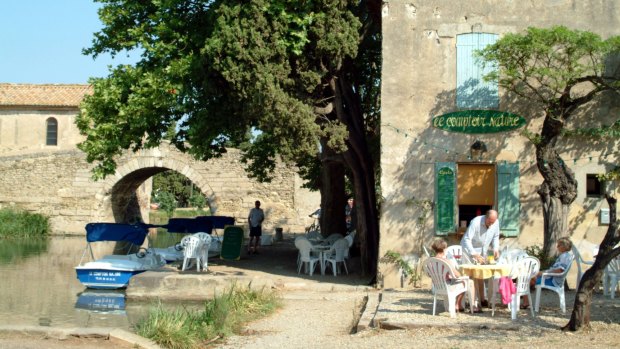
Canal du Midi at Le Someil, a 17th-century port with an 18th-century stone bridge.Credit: Alamy
Its hundreds of features – aqueducts, feeders, locks, staircase locks, siphons, spillways – are certainly striking but the plane trees lining the canal are what give it a distinct elegance. There were 42,000 planted in the 1830s to stabilise banks, shade barges and reduce evaporation but a fungus called Ceratocystis plantain has infected them. Carefully managed felling and replacement of trees is under way.
Following a waterway is like being in an open relationship with someone you're in love with: there's structure and freedom. The surrounding countryside is rich in fresh produce and we deviate from the canal to forage at village markets and visit vineyards. The train line is nowhere in sight but never far away if plans change.
There's plenty of waterside dining and during that week we consume a ridiculous amount of crepes, croissants, apricot confiture, coffee, baguettes, local wine, duck confit and cassoulet. One afternoon I really just want salad for lunch and not the whole three courses of the plat du jour, with duck heart seven ways. But the response is a waggled finger and a very definite "no". Duck is everything in these parts whether you're devouring it or doing so to avoid being garrotted by low-tied mooring ropes.
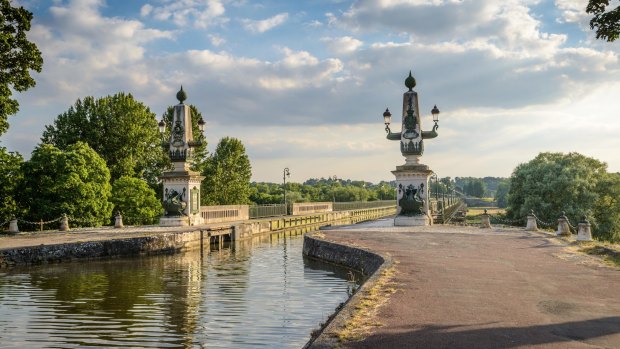
Bridge-canal intersection with Loire river, Briare, France.Credit: Shutterstock
Although it's June and the Canal du Midi draws more than 2 million visitors a year, there are very few people either walking or cycling the towpath. That means we can whip past the pleasure barges restricted to eight kilometres an hour and required to negotiate all 63 working locks.
There are times I'm caught up in the riding and there are moments I'm completely blown away by the canal itself. Especially when cycling alongside the canal across an aqueduct over a river – like life imitating Escher – or rolling through the world's oldest canal tunnel. The 165-metre long Malpas is part of Grand Bief (long reach) where the Canal du Midi maintains an altitude of about 31 metres above sea level for the 54 kilometres between the village of Minervois and Riquet's birthplace of Béziers.
In Agde, after a long unshaded stretch, we celebrate our nearness to the Med by drinking pastis while watching water jousting on the Herault river. It's taken four days to get this far and we only have three left to get back to Toulouse.
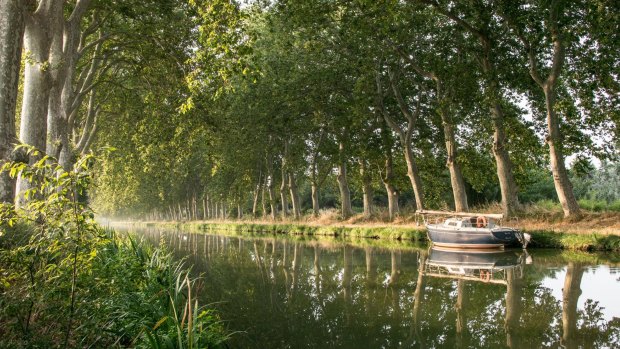
The Canal du Midi in the morning in Beziers, southern France.Credit: Shutterstock
The mistral headwinds us for much of the return journey. When we pedal into Toulouse late that final evening totally and utterly fatigued, I feel I've given everything to the Canal du Midi. But Riquet gave more. When the canal officially opened in 1681 he had already died the previous year with only five kilometres left to go.
FIVE WATERSIDE ROUTES IN BRITAIN AND EUROPE
LA FLOW VELO
This 290-kilometre cycling route starts along the Charente River near the Atlantic Coast and ends several waterways later in Thiviers, in the Dordogne. It's one of France's newest bike routes. See laflowvelo.com
EUROVELO 6
Cycle some or all 3653 kilometres from the Loire River at the Atlantic Coast to the Black Sea, from France to Bulgaria, taking in 10 countries en route. See eurovelo.com
VIARHONA CYCLE ROUTE
This 815-kilometre route from Switzerland's Lake Geneva into France and to the Mediterranean follows the Rhone, one of Europe's great glacially-fed rivers. See en.viarhona.com
TRENT AND MERSEY CANAL
The 150-kilometre canal passes some of the woodlands, meadows, marshes, ponds, grand halls, model farms, formal gardens and hyphenated names of Derbyshire, Staffordshire and Cheshire. See sustrans.org.uk
SCOTTISH CANALS
Ever considered cycling from Glasgow to Edinburgh? It's only 97 kilometres on the Fourth and Clyde Canal and the Union Canal via Falkirk. See sustrans.org.uk
TRIP NOTES
Elspeth Callender travelled at her own expense.
MORE
FLY
Qantas flies daily from Sydney and Melbourne to Toulouse with one or two stopovers. See qantas.com.au
STAY
In Toulouse, Pullman Toulouse Centre. Be sure to book ahead in summer. See accorhotels.com
RIDE
Bring your own or hire a hybrid bike and accessories from La Maison du Velo, which can also advise on canal conditions and detour options after floods or storms. Some sections of the route are subject to regular canal towpath work and may have detours in place. See maisonduvelotoulouse.com
Sign up for the Traveller Deals newsletter
Get exclusive travel deals delivered straight to your inbox. Sign up now.